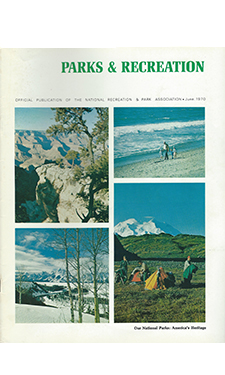 Last month, we looked at the June 1966 issue, one of the first issues of Parks & Recreation magazine after NRPA incorporated in August 1965. Fast forward a few years to the summer of 1970. Vietnam War protests were at a peak, and The Beatles had just released their final album in May. The first Earth Day was celebrated in April, and the Environmental Protection Agency would soon be established in December. NRPA was about to celebrate its fifth birthday.
Last month, we looked at the June 1966 issue, one of the first issues of Parks & Recreation magazine after NRPA incorporated in August 1965. Fast forward a few years to the summer of 1970. Vietnam War protests were at a peak, and The Beatles had just released their final album in May. The first Earth Day was celebrated in April, and the Environmental Protection Agency would soon be established in December. NRPA was about to celebrate its fifth birthday.
The cover feature this month focused on America’s living heritage of its national parks. Both the Secretary of the Interior Walter J. Hickel and Director of the National Park Service George B. Hartzog Jr. shared their thoughts in this special section, and they commented on ensuring the relevance of parks to the public and the ongoing debate between preserving natural landscapes and providing access for public use. Both are sentiments that everyone in the broader park and recreation field can appreciate, even 45 years later. Among other articles, the section also dug into current environmental education opportunities offered by national parks as well as challenges they experienced, and it concluded with “A Look into the Future,” in which the editors considered future developments in national parks.
Of particular interest in our current money-themed issue, the June 1970 edition also included a feature on “The Economics of Recreation Today.” Distinguished leisure researcher Richard Kraus, Ph.D., explored then-current spending on recreation. He quoted the January 1970 National Economic Review of The New York Times, which affirmed, “At the dawning of the seventies, leisure has become an essential part of American life, with a pattern of growth significantly greater than that of the economy.” Encouraging words indeed.
Kraus went on to discuss the variable definition of “recreation,” which accounts for the wide range of reported spending from various sources. Pulling information from several sources, he estimated annual spending on recreation as this field defines it to be approximately $132.15 billion per year in 1970. However, this total is widely split between private and public spending, indicating a major problem for agencies. “The imbalance between private spending on recreation ($125.9 billion) and public, voluntary agency or employee program spending ($6.25 billion) has meant that many recreation and park operations serving the public at large have been starved for financial support.” Kraus stressed the need for substantially increased public funding as well, largely to even the playing field for the 25.4 million Americans at the time with family incomes below the minimum subsistence level. “They are largely dependent on the network of recreation and park facilities and programs provided by public agencies for constructive leisure opportunities. To permit such programs to depend increasingly upon fees and charges to support capital development and current operations will mean, more and more, that poor people will be excluded from all but the most minimal and barren facilities.”
Today, community park and recreation agencies continue to be some of the great equalizers in American society, but the struggle for adequate funding continues. Kraus ends with the following thoughts. “While we may be impressed by the fact that Americans today spend over $132 billion each year to meet leisure needs, this does not mean very much in impoverished neighborhoods...where the only recreational opportunities are likely to be limited to a poorly equipped, littered and unattended playground — or to the corner bar. Our public and private expenditures on recreation need to be placed more nearly in balance.”
Danielle Taylor is the Executive Editor of Parks & Recreation magazine.

